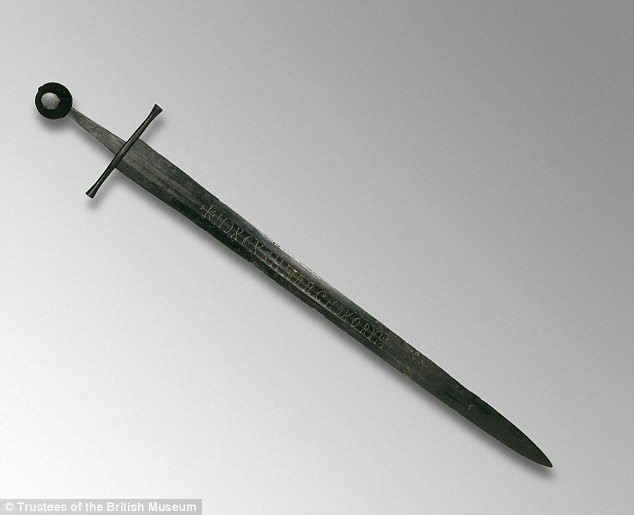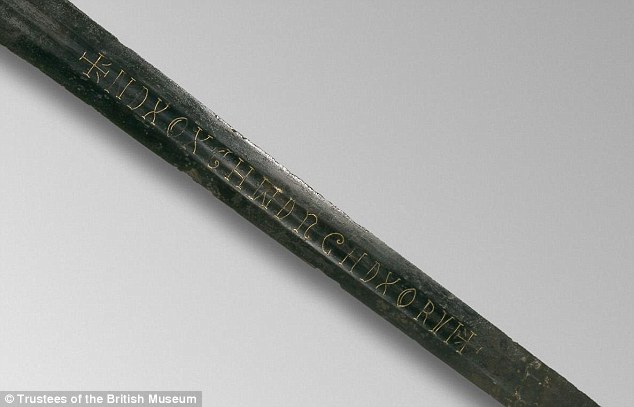It looks like you're using an Ad Blocker.
Please white-list or disable AboveTopSecret.com in your ad-blocking tool.
Thank you.
Some features of ATS will be disabled while you continue to use an ad-blocker.
Can you solve the code in the sword? British Library appeals for help in cracking enigmatic code
page: 1share:
Figured this might be something ATS could have a little fun with.
So the British Museum is asking for a hand in cracking the 18 letter inscription on a sword found in 1825. The inscription reads : NDXOXCHWDRGHDXORVI.
I'm sort of guessing if it's figured out it's going to be a sex pun or fart joke, but it's still interesting.


It is thought to be from the 13th century, and to have belonged to a medieval knight. The language of the inscription is unknown, but it's been postulated the sword was made in Germany.
Apparently, it could also mean nothing.
I like that the article mentions how people get Chinese or Japanese symbol tattoos and often don't have any idea if they actually say anything.
I like this attitude. It IS a fun game to play. The more exposure the inscription gets, the more chances someone will recognize it, which is why it is now on ATS for all us weirdos to see!
Link
So the British Museum is asking for a hand in cracking the 18 letter inscription on a sword found in 1825. The inscription reads : NDXOXCHWDRGHDXORVI.
I'm sort of guessing if it's figured out it's going to be a sex pun or fart joke, but it's still interesting.


It is thought to be from the 13th century, and to have belonged to a medieval knight. The language of the inscription is unknown, but it's been postulated the sword was made in Germany.
'The variety of languages that people are speculating its written in is interesting from Sicilian to Welsh'.
Janet Kennedy believes CHWDRGHD – in the middle of the inscription – is a misspelling of the German word for sword, making ORVI a name.
However, Joe commented on the blog: ‘It looks like medieval Welsh: “No covering shall be over me,” possibly meaning the sword and it's' owner will always be ready for battle’.
Apparently, it could also mean nothing.
‘Saxon swords in particular often had inscriptions on them that didn't actually say anything because the people buying them (or making them) were illiterate.
I like that the article mentions how people get Chinese or Japanese symbol tattoos and often don't have any idea if they actually say anything.
Harrison said: 'I'm not optimistic we'll ever find a definitive answer [as to what the inscription means] but it's a lovely game to play.'
I like this attitude. It IS a fun game to play. The more exposure the inscription gets, the more chances someone will recognize it, which is why it is now on ATS for all us weirdos to see!
Link
a reply to: Domo1
I'd say this bit here is correct
because theres only 2 vowels on it and they're both the letter 'O'...
So im going with the above quote
I'd say this bit here is correct
‘Saxon swords in particular often had inscriptions on them that didn't actually say anything because the people buying them (or making them) were illiterate.
because theres only 2 vowels on it and they're both the letter 'O'...
So im going with the above quote
a reply to: Domo1
Looks very much like 14th century Welsh. Similar in style as this Cardiff 14th century iron sword.
14th century Cardiff sword
Looks very much like 14th century Welsh. Similar in style as this Cardiff 14th century iron sword.
14th century Cardiff sword
a reply to: SecretKnowledge
Yeah, that's honestly what I would think even without reading that snippet, but you never know. It's still fun to speculate and hope some ATS weirdo (no dig, I embrace the weirdness) has some obscure knowledge of a long forgotten language (that was a little redundant I guess) and will be able to decipher the fart joke.
Yeah, that's honestly what I would think even without reading that snippet, but you never know. It's still fun to speculate and hope some ATS weirdo (no dig, I embrace the weirdness) has some obscure knowledge of a long forgotten language (that was a little redundant I guess) and will be able to decipher the fart joke.
a reply to: liteonit6969
Nice! They certainly appear similar! Even if it's nonsense, I feel like I'm going to enjoy reading responses and how quick members of ATS show what they know!
Nice! They certainly appear similar! Even if it's nonsense, I feel like I'm going to enjoy reading responses and how quick members of ATS show what they know!
I don't know what it says, but it is beautiful! Thank you for sharing. I love seeing things like this on ATS.
They should send it to the Forgotten Languages Website....
They should send it to the Forgotten Languages Website....
edit on 7-8-2015 by Doodle19815 because: (no reason given)
a reply to: Domo1
My first guess was Welsh or Breton of that time period. I am fascinated by the cruciform symbol that indicates the start and the finish of the sequence. I wonder if it is in fact something from the Christian scriptures in which each character represents the first letter of a word in a sentence. 'Tis a puzzlement.
My first guess was Welsh or Breton of that time period. I am fascinated by the cruciform symbol that indicates the start and the finish of the sequence. I wonder if it is in fact something from the Christian scriptures in which each character represents the first letter of a word in a sentence. 'Tis a puzzlement.
That sword looks too good, too well preserved, to be from the 13th century. Could they have dated it wrong?
new topics
-
Pentagon announces new military aid package for Ukraine
World War Three: 38 minutes ago -
CNN now has a pay wall
Other Current Events: 42 minutes ago -
Tucker Carlson Shares Amazing Story: "I Was Mauled By a Demon"
Paranormal Studies: 1 hours ago -
Maetaquest 3S
Video Games: 3 hours ago -
Final jobs report before Nov 5th is a bad one lowest since Dec 2020
US Political Madness: 3 hours ago -
Early voting results
2024 Elections: 6 hours ago
top topics
-
Final jobs report before Nov 5th is a bad one lowest since Dec 2020
US Political Madness: 3 hours ago, 13 flags -
Candidate Harris Supporter MARK CUBAN Says Trump Has No Smart-Intelligent Women in His Orbit.
2024 Elections: 16 hours ago, 11 flags -
President BIDEN Approved Omitting from the Transcript That He Called Trump Supporters GARBAGE.
2024 Elections: 13 hours ago, 11 flags -
Early voting results
2024 Elections: 6 hours ago, 7 flags -
CNN now has a pay wall
Other Current Events: 42 minutes ago, 6 flags -
Tucker Carlson Shares Amazing Story: "I Was Mauled By a Demon"
Paranormal Studies: 1 hours ago, 5 flags -
Pentagon announces new military aid package for Ukraine
World War Three: 38 minutes ago, 5 flags -
Project Redsun: NASA's Secret Manned Missions to Mars The Why Files
Space Exploration: 12 hours ago, 4 flags -
Strong and Intelligent women
2024 Elections: 15 hours ago, 4 flags -
Maetaquest 3S
Video Games: 3 hours ago, 3 flags
active topics
-
Tucker Carlson Shares Amazing Story: "I Was Mauled By a Demon"
Paranormal Studies • 11 • : FullHeathen -
CNN now has a pay wall
Other Current Events • 8 • : hangedman13 -
Final jobs report before Nov 5th is a bad one lowest since Dec 2020
US Political Madness • 15 • : xuenchen -
British Man Jailed for over 2 Years for Shouting at Police During Protest has Died in Prison
Social Issues and Civil Unrest • 17 • : covent -
-@TH3WH17ERABB17- -Q- ---TIME TO SHOW THE WORLD--- -Part- --44--
Dissecting Disinformation • 3066 • : MetalThunder -
Mood Music Part VI
Music • 3677 • : underpass61 -
Pentagon announces new military aid package for Ukraine
World War Three • 2 • : matafuchs -
Remember when Iraq invaded Kuwait
History • 18 • : fringeofthefringe -
Old School Punk
Music • 555 • : underpass61 -
The Acronym Game .. Pt.4
General Chit Chat • 873 • : Moon68
